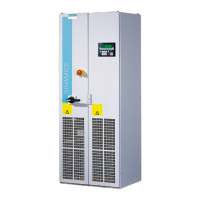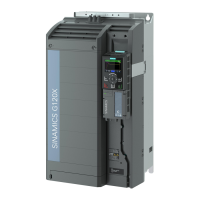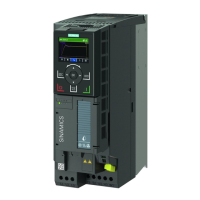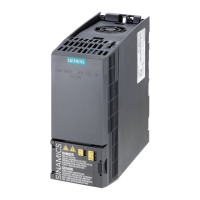When an alarm is active, the converter responds in 2 stages:
• Stage1: Reduction of the pulse frequency
The converter only responds with stage 1 for an excessively high chip temperature of the
power electronics or for an excessively high heat sink temperature.
If the converter is operated with an increased pulse frequency, when an alarm is active, then
the converter reduces its pulse frequency starting at the pulse frequency setpoint p1800.
Once the impending overload condition has been removed, the converter increases the pulse
frequency back to the pulse frequency setpoint p1800.
• Stage 2: Reduction of the output current
The converter responds as follows if stage 1 is not possible or was not successful:
– For closed-loop speed control, the converter reduces the output current.
– For U/f control, the converter reduces the speed.
Once the impending overload condition has been removed, the converter re-enables the
output current or speed.
If the overload response does not prevent a converter overload, then the converter switches
o the motor and issues a fault.
Overload response when p0290=3
The converter signals an alarm for an impending overload condition.
If the converter is operated with an increased pulse frequency, when an alarm is active, then
the converter reduces its pulse frequency starting at the pulse frequency setpoint p1800.
The converter only reduces the pulse frequency for an excessively high chip temperature of
the power electronics or for an excessively high heat sink temperature.
Once the impending overload condition has been removed, the converter increases the pulse
frequency back to the pulse frequency setpoint p1800.
If the overload response does not prevent a converter overload, then the converter switches
o the motor and issues a fault.
Overload response when p0290=12
The converter signals an alarm for an impending overload condition.
When an alarm is active, the converter responds in 2 stages:
• Stage1: Reduction of the pulse frequency
The converter only responds with stage 1 for an excessively high chip temperature of the
power electronics or for an excessively high heat sink temperature.
If the converter is operated with an increased pulse frequency, when an alarm is active, then
the converter reduces its pulse frequency starting at the pulse frequency setpoint p1800.
Once the impending overload condition has been removed, the converter increases the pulse
frequency back to the pulse frequency setpoint p1800.
• Stage 2: Reduction of the output current
The converter responds as follows if stage 1 is not possible or was not successful:
– For closed-loop speed control, the converter reduces the output current.
– For U/f control, the converter reduces the speed.
Once the impending overload condition has been removed, the converter re-enables the
output current or speed.
Functions
14.11Drive functions
SINAMICS G220 converter
624 Operating Instructions, 04/2024, FW V6.2, A5E51781573B AB
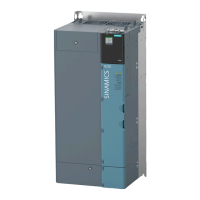
